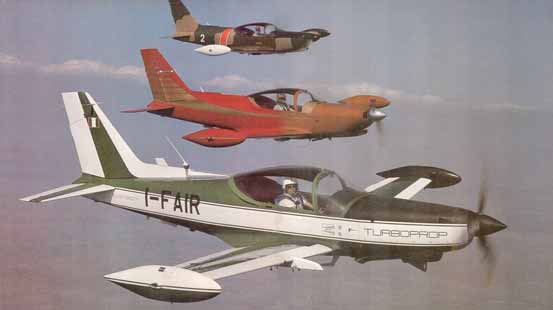
SF 260
MARCHETTI!! |
 |
KICKIN' BUTT IN
THE SF260C AND TURBOPROP 260! |
I've always considered the SF260 to be the ultimate personal airplane. This was written 20-25 years ago and I've flown nothing that has made me feel any different since. For that reason this is a much longer pirep for a lot of different reasons. Among others I go through the difference between the early and late airplanes (I prefer the early straight 260's) and I fly the TUROPROP POWERED SF260TP! Hey, someone has to do it, right? Don't miss the tales at the end about demoing airplanes in third-world countries. Some funny stuff there! Ah, yes—the Italians. Their's are the absolute
finest of obsessions. The list of magnificent Italian obsessions includes:
beauty in all things, sex, speed, sex, visual and physical excitement,
and, you guessed it—sex. These categories are requisite in all
objects Italian . . . from Sophia Loren to Ferraris, from architecture
to their cooking. To be Italian an object must be finely crafted and
finely formed. This object must be possessed of graceful performance,
but with a hidden touch of danger under the satin. This describes the
Siai-Marchetti SF.260 in all its variations. It is the quintessential
aluminum Italian.
The reciprocating SF.260 is currently in use by twenty-four air forces as a basic and quasi-advanced trainer and a total of 800 have been put into uniform. Although there is considerable controversy as to exactly what a military trainer is and what it must do, in most ways the SF.260 must be one of the very best. In any type of trainer the concept of challenging the student to expand his learning envelope—yet making the aircraft manageable enough so as not to discourage him—is a complex problem for the designer. In today's economy, those first forty or fifty hours of flight time are critical because the student attrition rate is norm-ally extremely high because of talent limitations, so the dollar per student must be kept to an absolute minimum. The airplane must be inexpensive to fly yet be capable of teaching those who will continue as well as eliminating those who don't have basic capabilities. The SF.260, especially the later C models, do that admirably. However, the SF.260 has a number of other factors in its favor. In the first place, it is a true high-performance airplane that stands with one foot in the primary training area and another in the tougher basic training categories. The SF.260 has taken students from first flight to their first step into a jet. The Belgian Air Force currently transitions their students directly out of the SF.260 into the state-of-the-art Alpha jet. OVER AND ABOVE BEING A TRAINER THE SF.260s are equipped with pylons
and hard points under the wings to carry a variety of weapon stores
in an effort to convert the plane into that often attempted, but never
quite achieved, design goal of COIN (counter insurgency) mini-fighter.
For thirty years or more, some companies have thought that smaller
under-developed countries could profit from having a low-powered, medium
speed weapon delivery system that would let them go tearing around
over the bush putting down local rebellions. Somehow, this has never
really worked but the SF.260 certainly comes as close as any in filling
that role. In fact, several unnamed countries have had a number of
combat losses in SF.260s. The turboprop version has an extra 100 horses
and higher speeds which should make for a much better COIN fighter.
In fact, the SF.260 TP may indeed make that category absolutely useful. |